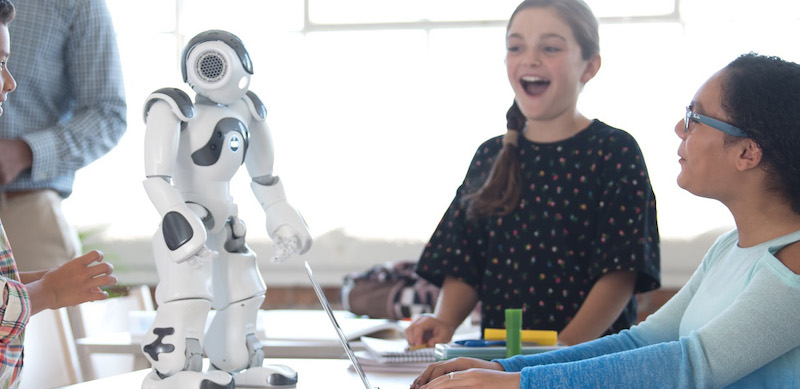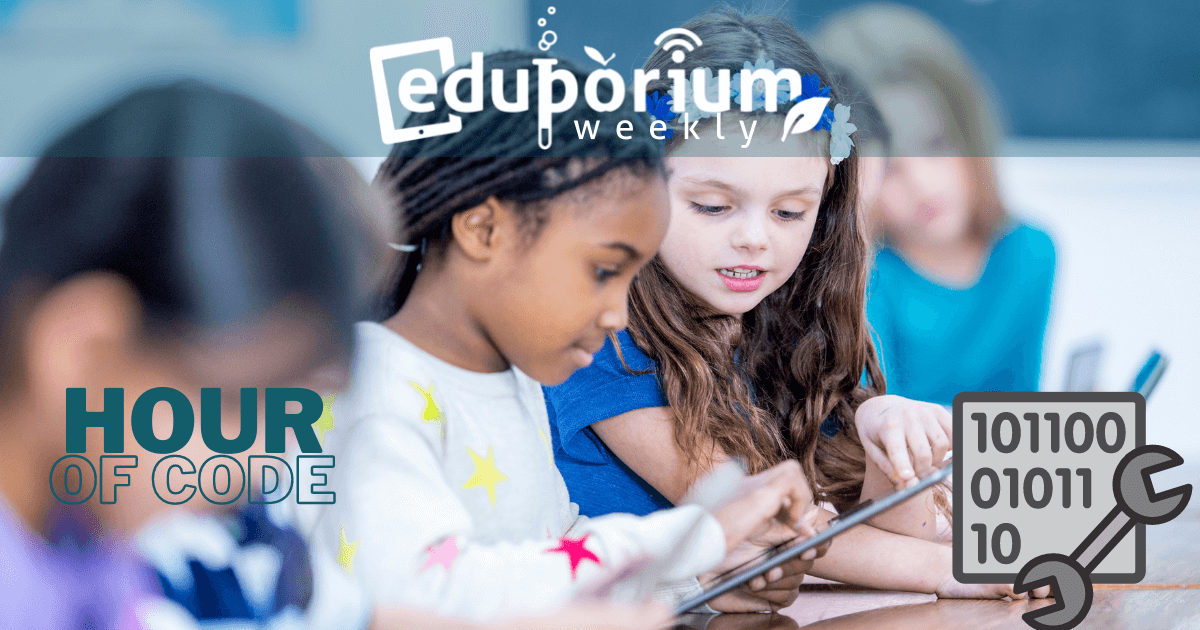The annual Computer Science Education Week put on by Code.org serves as a yearly reminder of the importance of coding and Computer Science education in contemporary K-12 schools. Expected to be the literacy of future generations, coding has become an extremely important skill to have and creative Hour of Code projects are key in exposing students to what it’s like to work with powerful technology to accomplish large-scale tasks. As this year’s CS Ed Week wraps up, let’s look back at what makes it successful each year.
Coding: More Than an Hour at a Time
There’s a good chance in the next decade or so that coding proficiency will be synonymous with success. Graduates with coding and computer science skills are instantly valuable to employers. So much of the modern and future workforces involve working with various programming languages. Knowing how to code means knowing how to think like a computer scientist, framing problems in the same ways as computer scientists, and solving problems creatively while using technology. While programs like the Hour of Code are great for real-life coding challenges, it only comes around once a year. A concentrated effort to expand classroom computer science, however, could make it more likely that students who participate in the Hour of Code annually will retain the skills and concepts they learn rather than forget them due to a year away from practice.
For many students, especially girls and minority members, the reason they do not pursue computer science as a career option is because they are not given the opportunity to explore it early on in their education. Many science and tech entrepreneurs, including Bill Gates and Mark Zuckerberg, have launched campaigns to promote coding and computer science. The advent of Computer Science Education Week came as a result of this desire to bring coding into the classroom and to train teachers to effectively teach it for more than just one week out of the year. Most states and districts do not have formal computer science requirements in their curricula. This is more than likely to change in the next decade or so, however. For those that do not, the Hour of Code is a simple way to get kids thinking about computer science.
The Hour of Code, however, is more than a week-long opportunity to give kids who don’t normally get to learn computer science the chance to try it. It’s more important that Hour of Code programs lead to the widespread adoption of Computer Science courses in K-12 schools. As of now, only six states in the country are actively funding computer science programs for their students. The thought is that by introducing computer science in the early grades, rather than waiting until high school, students will be much more successful in taking on the challenges they’ll face. Once they learn the foundational elements, students can apply their computer science skills to everything. Learning concepts within coding and computational thinking allows students to break problems down into smaller parts. This is what helps them manufacture the solutions they need to solve them creatively and efficiently.
Mixing the Hour of Code with Robotics
Our guess is a lot of teachers did just that this past week. Much of the coding students do in the classroom involves robotics. Robots help engage students by providing them with learning activities that are fun and cater to their personal interests and hobbies. Luckily for teachers and for the development of students, to get many of these robots to function, kids need to program them to understand and execute specific commands. It’s a very simple way to introduce kids to programming, but, a lot of the time, simple is best. When teachers begin exposing students to coding, they tend to start by using robots and there’s good reason why.
The Hour of Code is all about keeping it simple while exposing students to age-appropriate programming challenges. These days, there are no shortages of educational robots that incorporate coding activities in a number of different ways. With some, like the Ozobot, kids are color coding—creating linear cues for the robot to follow simply by drawing them with different colored markers. When learning with the mBot, they are programming with mBlock, a web-based and block-based programming language that provides block-based commands to the robot over a Bluetooth connection. In either case, students are able to write programs by combining multiple commands to compel the robot to execute a series of movements, like complete a circle or navigate a challenging obstacle course. Other robot options for K-4 students engaged in the Hour of Code include the Edison Robot, Code-a-Pillar, Dash and Dot, Cubelets, Finch, and MiP among others.
For older students, they can continue programming with robotics in a variety of ways as well. There are robots available with more advanced capabilities, like the Meccano Meccanoid or the EZ-Robot—both of which have different versions for customizable learning experiences. There’s also the NAO Robot—perhaps the most advanced humanoid robot on the market at the moment. Though quite pricey, NAO mimics human movements and is able to walk and glide in ways that robots, frankly, shouldn’t be able to do. It can recognize and respond to thousands of commands and can help students learn the more intricate aspects of coding. If your Hour of Code this year involved programming and learning with robotics, that’s fantastic! If not, you now have some fresh options to explore for next year’s Computer Science Education Week!

What You Need For a Successful Hour of Code
Getting students started with computer science can be tricky, especially if teachers aren’t exactly sure how to plan it. Not to fear—like every education initiative, troubles can be avoided with some simple hints. We recommend that all teachers who are planning on leading an Hour of Code activity get familiar with the concepts and the technology that the students are going to be using during Computer Science Education Week. There are lots of tutorials available on the Web that provide teachers with starting points. They also provide recommendations for project ideas and technology tools to use. Once teachers have got the hang of it, it’s also helpful to show students the same tutorial before they begin.
When students try similar tutorials, they gain valuable experience in preparation for the real thing. Practice activities are beneficial because they require minimal prep time for teachers and lots of templates are available online. They're also often self-guided, which allows students to work at their own pace and skill level. For teachers of older grades, online lesson plans are available as well. A lot of them test the teachers’ skills and pertain to coding projects in specific subject areas. This is a useful approach for teachers who have led an Hour of Code in the past. Once you’ve got the hang of your technology and have some good activity ideas in mind, start promoting! The Hour of Code is one of the most talked about STEM education activities of the year with millions of teachers and students engaged in online conversations about their accomplishments all week long.
The real success of Hour of Code activities comes from the work put in during the preparation stages, however. Teachers must plan their technology needs, like whether they should use a laptop or tablet or if they need either. Consider the bandwidth strength in the classroom as well and make adjustments accordingly. It’s also good to launch your Hour of Code with an inspirational video or speaker so kids can see how coding is used so frequently in today’s professions. After showing this video (if you choose to), it’s important to start strong. It’s okay if both teachers and students are new to computer science. You can collaborate to explore how technology impacts our daily lives, discover things that use code every day, and spark student interest in computer science and coding. Then, just jump right in and encourage students to code their way to brilliance early and often!
Teachers’ Roles During the Hour of Code
Computer Science Education Week is, of course, very useful to students, but it is equally valuable to teachers. During this, they can expose students to CS topics, like how the Internet works and how to make an app. The things students learn during an Hour of Code are likely to become commonplace in K-12 classrooms over time. Due to the current and future workforces being highly focused on computer science and coding, it’s perfectly reasonable to think that the classic classrooms that feature dramas and plays, word problems, and spelling tests will undergo a 21st century transformation. With that, they'll likely feature coding and programming lessons on a more regular basis.
Computer Science Education Week and particularly the Hour of Code play a fairly sizable role in this transformation. In fact, they serve as stepping stones for teachers who are looking to launch computer science programs in their schools. To get their feet wet, teachers can first engage in one of the many online coding tutorials available. They'll find everything from lesson plan ideas to technology needs and even inspirational videos. To get students excited, it’s even common for teachers to grab some Hour of Code T-shirts or print participation certificates. These help kids remember what it is they have accomplished during this all-important week. It’s important too to keep in mind that an educator’s attitude toward the Hour of Code will probably rub off on students, so it would be really good to get excited about coding and encourage kids to explore all the cool possibilities it has to offer!
One other thing teachers can do is visit Code.org and sign their petition for computer science in every state. The goal is getting computer science into schools in all 50 states at all grade levels and you can help. This also helps teachers gain an understanding of what Computer Science is like in their own education systems. For instance, they can learn if their state has funding dedicated to CS programs, if it has resources for developing K-12 CS standards, or even how many vacant computing jobs there are. Above all else, however, the best way for teachers to participate in CS Ed Week is volunteering. If they have experience in computer science or have led an Hour of Code before, volunteering is crucial. It’s easy to find a program or create one at your school and spread your knowledge to the future programmers.

Keeping Coding Going After Computer Science Education Week
Once a year, during Computer Science Education Week, teachers commit to inspiring their students to pursue computer science. Don’t get us wrong—the events of CS Ed Week, especially the Hour of Code, are phenomenal. The only problem is that they typically only last for that one week. For whatever reason (usually a lack of funds and resources), schools feel they are unable to continue their coding initiatives during the rest of the school year. The main goal of Computer Science Education Week is to spark change that eventually leads to Computer Science for all. We argue that it should extend past ‘for all’ and include ‘for all—all year.’ But, how can schools and districts find ways to make this happen?
Hour of Code events are great for inspiring creativity in children and ideal for providing them with tech-based activities from which they can learn valuable skills. For schools that don’t see Computer Science outside of this one week in December, it’s challenging to find a place for it in the curriculum. The truth is, however, that schools can incorporate it in any one of their core classes. Students can use programming in almost any subject—math, science, English, history, art, social studies—so long as they have creative projects available to them. Coding can be used everywhere from middle school science classes to help students run simulations or in larger project-based activities in K-5 classrooms. The opportunity to engage in coding throughout the school year is very beneficial for students, especially for those who learn best by doing.
By integrating computer science into everyday education, coding helps students build their overall STEM skills. Especially for kids who think they’re not interested, coding encourages trial and error and productive failure, which are each important for success in the real world. We hear a lot about the STEM gap or the skills gap in education. One way to shrink it is to ensure that students are able to have Computer Science Education Week every week. To encourage participation, students can collaborate on group projects and challenge their friends to invent devices that increasingly become bigger and better. Unfortunately, many school leaders simply forget about coding once CS Ed Week comes to a close. It's becoming more apparent, however that they're not going to be able to afford doing that for much longer. The goal is “Computer Science for All.” It shouldn’t stop after just one impactful week.
For the latest EdTech, STEM, and 21st century education news, follow us on Twitter and Instagram. Like us on Facebook, too, or sign up for our newsletter for our latest product announcements and offerings. If you have an idea for an Eduporium Weekly theme, send us a message on social media or comment below.



